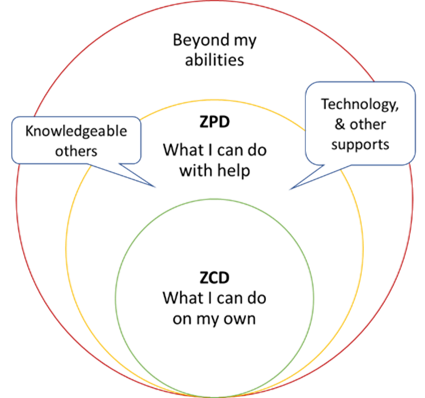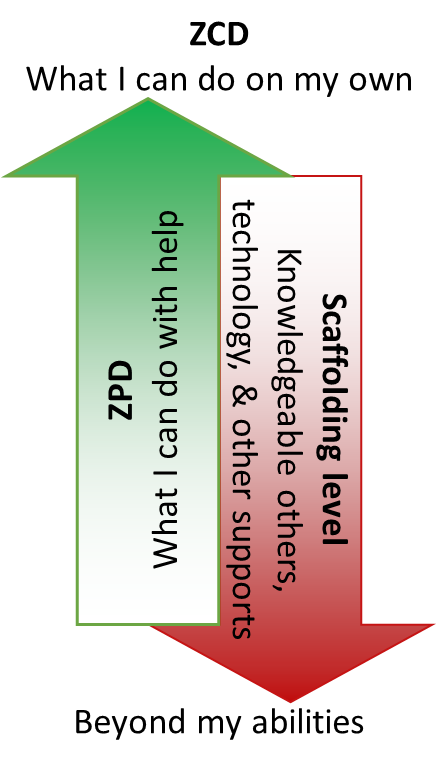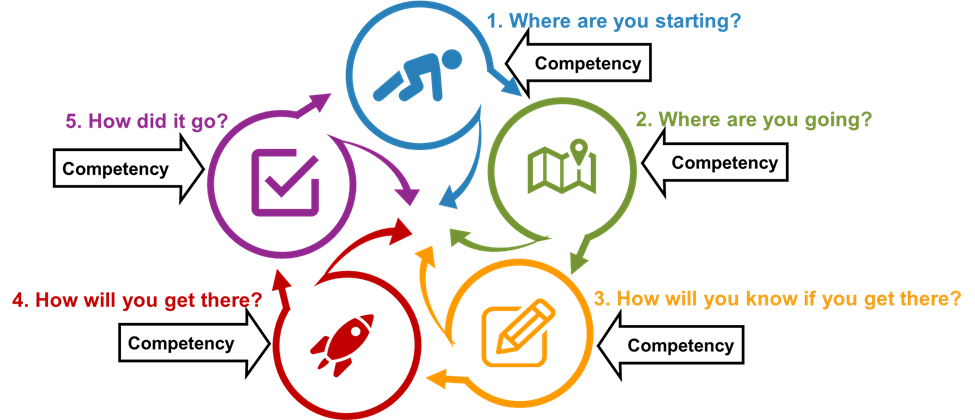
Unit A – Teaching & Learning Theories
A9. Student Competency
Student Competency
Zone of Proximal Development & Scaffolding
The Zone of Proximal Development (ZPD) is the developmental area – the area or level the student is capable of with support (Vygotsky, 1978, p. 86). The student is supported by others, including, possibly, other students and/or technology (See Figure 1).
Figure 1: ZPD Growth

The Zone of Current Development (ZCD) represents the level that the learner can reach through independent problem solving.
Scaffolding refers to the supports that help a student learn and move from dependent to independent in a specific ability. This could help in structuring thinking or arranging elements to help the student learn. Supports could be knowledgeable others (instructors, peers, experts…), technology, and other tools (such as books, instruction guides, policies and procedures…). As the ability grows, the help and scaffolding can be slowly removed. Therefore, a person’s ZPD and ZCD change as the individual grows his ability to act independently (See Figure 2).
Figure 2: ZPD & Scaffolding

Wass et al. (2011, p. 322) found that providing scaffolding and slowly removing it, supporting students’ growth in ZCD and critical thinking, also helped the students growth epistemologically: “Learning through research appeared to scaffold a change in second year. All students who took part in the study moved from a view of knowledge as something incontestable, to a position where epistemological uncertainty became an important part of their emerging identity as inquirers.”
McLeod (2019) states that to help someone progress, you can focus on three important components which aid the learning process:
- “The presence of someone with knowledge and skills beyond that of the learner (a more knowledgeable other).”
- “Social interactions with a skillful tutor that allow the learner to observe and practice their skills.”
- “Scaffolding, or supportive activities provided by the educator, or more competent peer, to support the student as he or she is led through the ZPD.”
Silver (as quoted by McLeod, 2019) suggests instructors:
- “Assess the learner’s current knowledge and experience for the academic content.”
- “Relate content to what students already understand or can do.”
- “Break a task into small, more manageable tasks with opportunities for intermittent feedback.”
- “Use verbal cues and prompts to assist students.”
Competency vs Confidence Quadrants
When you need your students to absolutely know how to do a specific task, you may want to consider how much you have them practice that particular skill. To move from incompetence to competence, the student will need practice, going through the four stages of Unconscious incompetence to conscious incompetence to conscious competence and finally to unconscious competence (See Figure 3 and Table 1).
Figure 3: Competency & Confidence

Initially created at Gordon Training International by its employee Noel Burch in the 1970s, this theory points out that a person’s awareness of their competence is often incorrect and this needs to be remembered when providing students with practice (“Four Stages of Competence,” 2018).
Key questions:
- When working with students, which level of confidence and competence will they need in order to apply what you are teaching them?
- How much practice will most students need to get to this level?
The level of competence and confidence needed will be dependent on the specific topic. Example: If I am building a presentation for a conference, I do not need to have memorized all of Mayer’s principles. Instead, I need to know that they exist and how to find them. I have practiced applying them at different times previously, so just need a refresher. I have confidence in my ability to find and apply when needed.
Table 1: Competency & Confidence Quadrants from Burch
| Step | Stage | Example |
| Unconscious incompetence | The learner does not know how to do something and is not aware of how incompetent they are | “Driving a car is easy and I am going to be able to drive with no trouble.” |
| Conscious incompetence | The learner has started to learn the process and is very aware of their incompetence | The new driver may be very aware that they have a death-grip on the wheel and that they don’t know how to gently break. They realize how much they can’t do well. |
| Conscious competence | The learner has gained some skill but is still very aware of every action | a new driver who wants to make a lane change may be very conscious of the steps (shoulder-check, turn-signal, wheel-turn) as they make them |
| Unconscious competence (Automaticity) | The skill is now second nature | The driver is tuning the radio, chatting with a friend, and eating while changing lanes |
Memorize or Find?
Another perspective is that you might expect that your students will be able to recall certain aspects of their learning from memory, while in other cases you will want them to know how to find information. E.g., Frank Dooley (personal communication) expects that his students in AGEC 20300 will use their book, notes, or Google to find the formula to calculate a cross-price elasticity of demand. But he expects that they will know from memory that a negative sign for a cross-price elasticity means the two products are compliments.
If you want your student to memorize information, you can use flashcards, mnemonics, spaced repetition, etc. – these are lower-order thinking skills activities.
If you want your students to be able to find information, you could use different assignments and assessments.
IDI & Student Competency

The following describe actions you can take to use concepts from Student Competency in the IDI model:
Step 1. Where are You Starting?
1.1 Review Course Requirements
- Review the pre-requisites to determine what the students have already been exposed to on each learning outcome.
- Based on post-requisite courses, estimate the levels of competence and confidence students will need in subsequent courses.
Step 2. Where are You Going?
2.1 Write Learning Outcomes & Objectives
- Tell students about the level of confidence and competence they will need in order to apply what you are teaching them.
2.2 Finalize Learning Model
- Consider how much practice most students will need to get to the needed competency and confidence level and what types of activities will get them there.
Step 3. How Will You Know If You Get There?
3.1 Develop Assessments & Rubrics
- “Assess the learner’s current knowledge and experience for the academic content” (McLeod, 2019)
- Identify how you will assess competence and confidence.
Step 4. How Will You Get There?
4.1 Develop & Teach Course
- “Assess the learner’s current knowledge and experience for the academic content” (McLeod, 2019).
- “Relate content to what students already understand or can do” (McLeod, 2019).
- Provide scaffolding,
if necessary breaking new content such as points of view into smaller units, and provide with feedback (McLeod, 2019). - Think about the level of confidence and competence students will need in order to apply what you are teaching them.
- Consider how much practice most students will need to get to the needed competency and confidence level and what types of activities will get them there.
- “Relate content to what students already understand or can do” (McLeod, 2019) .
- “Assess the learner’s current knowledge and experience for the academic content” (McLeod, 2019) .
- Watch students carefully as they demonstrate their abilities in the topic to ensure that they are working within the ZPD or ZCD.
- Provide scaffolding as needed (including peer tutoring).
- “Use verbal cues and prompts to assist students” (McLeod, 2019).
- Consider guest presenters, project observers, and/or project tutors (with knowledge and skills beyond that of the learner) (McLeod, 2019).
- Maximize “social interactions with a skillful tutor that allow the learner to observe and practice their skills (McLeod, 2019).
Step 5. How Did It Go?
5.1 Evaluate Course Success
- Use the class outline to note how various activities worked.
References
Burch, Z. A. (2018). Faculty Perspectives on Redesigning Classrooms with Active Learning Technology Tools. In ProQuest LLC. ProQuest LLC.
Four stages of competence. (2018). In Wikipedia. https://en.wikipedia.org/w/index.php?title=Four_stages_of_competence&oldid=831063780.
McLeod, S. (2019). Zone of Proximal Development and Scaffolding. Simply Psychology. https://www.simplypsychology.org/Zone-of-Proximal-Development.html.
Vygotsky, L. S. (1978). Mind in Society: The Development of Higher Psychological Processes (M. Cole, V. John-Steiner, S. Scribner, & E. Souberman, Eds.; Revised ed. edition). Harvard Univ Pr.
Wass, R., Harland, T., & Mercer, A. (2011). Scaffolding Critical Thinking in the Zone of Proximal Development. Higher Education Research and Development, 30(3), 317–328.
